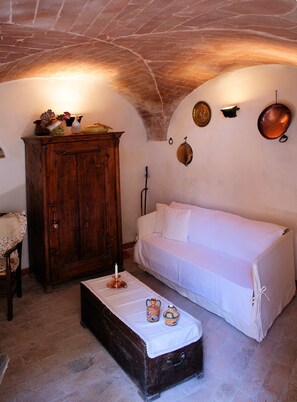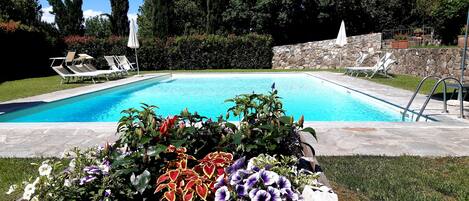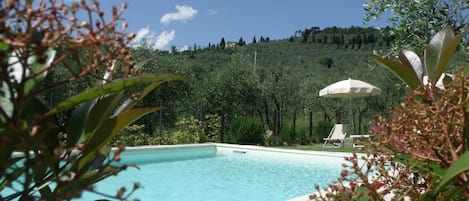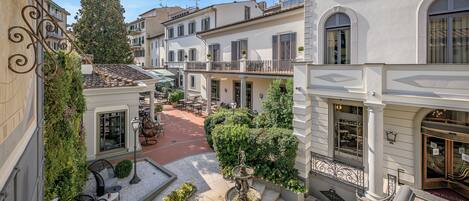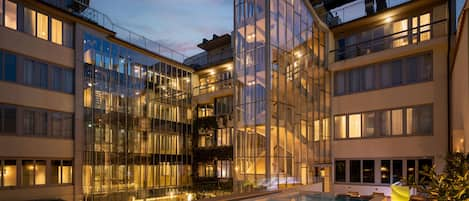Single house isolated from others, at the apex of a medieval village in LEGOLI, on the top of the hill, in the center of Tuscany. The property with restored antique finishes has a dining room with large fireplace with adjoining wood oven, kitchenette equipped with modern induction hob and infinite style furnishings and large table for up to six people. In addition there is the double bedroom, a living room with sofa bed, bathroom with shower, central heating, air conditioning and WiFi. Private parking space 20 meters from the house
Lo spazio
The three-storey mansion in old country style. It reached its current layout in the nineteenth century, and the renovation I made, was as conservative as possible, so you will be transported in an old atmosphere.
To enter the house there are two wooden doors, the first with a brass door , gives access to the small entrance with terracotta stairs to the first floor and a passage to the living room on the ground floor; the second entrance is a rustic wooden door complete with opening window with grate which gives direct access to the living room on the ground floor, it can be open during the day or night, so as to combine the living room with the external. That ground floor room is equipped with a sofa bed that can be divided into two separate beds and an original wardrobe. The room was an ancient stable and its function is espresse into authentic iron rings for the menagerie of animals,or in the vaulted ceiling terracotta cruise that wraps the room completing the embrace of the floor of the same ancient material. The room also gives access via a wooden door with a small window and a barrel-vaulted corridor to the original hemispherical cellar. It is dug into the tuff of the hill behind it and preserves a microclimate from a natural cave with a temperature of about 16 degrees, same in summer and in winter, perfect for storing food and wines.
If you continuing along the staircase, you will arrive at the dining room on the first floor which preserves the atmosphere of past centuries with a ceiling with wooden beams and terracotta bricks with oak beams (it caged with steel bars for the static safety of the building ), constitutive terracotta floor, antique style furnishings, built-in kitchen with modern induction fires and above all, the protagonist of the room, the large fireplace where you can enter standing with oak beam and wood oven all preserved identical from nineteenth century. Here you will also find all the pots suitable for cooking and serving on the table, all the cutlery you need, a particular selection of dishes and glasses housed in an ancient wooden plate and table linen.
From the dining room, a staircase partly in terracotta and partly in wood, gives you access to the bedroom on the second floor. This environment, the sloping attic ceiling, with wooden beams and terracotta bricks, brings you the attention to the large double bed with the tall antique bedside tables with marble top, next to the window from which you can admire a glimpse of the country below and the Tuscan hills around it.
In that second floor there is olso the small bathroom with a characteristic window that overlooks the arch in the center of the alley, a shower obtained in the thickness of the wall that was the castle wall and the toilet in a small room carved into a shelf on the facade with baseboards nineteenth-century terracotta drain pipe in faciade of the house.
Everywhere in the house, there are small recesses of the walls that were used in the past a bit as wooden lockers and shelves that have all been adorned with antique furnishings that give your living room, together with lace and lace and antique fabrics in profusion and attention to the restoration of the original furniture and the care and refinement of the details, the unique and dreamy flavor of the past.
Why I said in the title the refuge against the plague 1480?
In that I refered to the bubonic plague pandemic of the year 1480; if you want to read further, let me explain.
In fact, in those years, the Florentine painter Benozzo Gozzoli, famous for the peculiar fresco of the Cavalcade of the Magi at Palazzo Medici-Ricciardi in Florence, was working on the monumental fresco cycle of the Camposanto in Piazza dei Miracoli in Pisa (the cycle of largest frescoes in the world, made by various artists from the thirteenth to the sixteenth centuries, which covers all the large internal walls of the sacred place, unfortunately ruined by the bombings of 1944 but masterfully restored on site and of which are preserved in a dedicated museum, all preparatory drawings called sinopias). While he was completing the paint of the Noah's intoxication box, one of the great pandemics of bubonic plague broke out in the districts of Tuscany and to defend himself from his miasmas, then as now, Benozzo had to isolate himself in a remote place: Legoli.
Imprisoned in one of the few houses that then made up the village (why not, Lorenzo's house?) Of the small hill village, he kept his hand in training with a small order thanks to a poor collection of local peasant villagers, painting a moving fresco on four sides of a country newsstand still admirable today in an original setting on the east edge of Legoli.
Benozzo Gozzoli was engaged in the construction of the kiosk from 31 May 1479 to 11 January and in the theme of the crucifixion with saints and angels in Florentine Renaissance style with wings to color, the climate of fear is perceived for the virus that was raging, in the despair of Mary and St. John and in the cadaveric pallor of the Christ who died on the cross. Even more in the part that represents the unbelief of St. Thomas, with the finger that sinks into the scourge of the Savior's side, we understand the closeness and consternation of the death that then claimed so many victims.
1480 is the number that brings the small, historic town of Legoli to art and this is evidenced in the center of the village with the monumental sign of the high-level restaurant which precisely reports 14.80
The house is only for you and it is isolated on 4 sides from the other houses: there are no neighboring people despite being the house in the center of the village, in its highest part, below the high church which, however, is never officiated.
In Legoli village there have been no cases of Covid-19 so far.
Sanitization of the interiors of Lorenzo's house by UV rays



